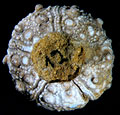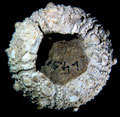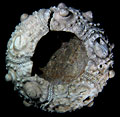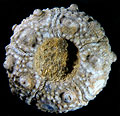The Echinoid Directory
Caenocidaris Thiery, 1928, p. 180
[=Besairiecidaris Lambert, in Besairie, 1936, p. 117, type species Besairiecidaris ankarensis Lambert, 1936; =Chesniericidaris Vadet, 2004, p. 27, type species Cidaris wrightii Desor, 1855.]
| Diagnostic Features |
|
|---|---|
| Distribution | Middle Jurassic (Aalenian, Bajocian); Europe, Madagascar. |
| Name gender | feminine |
| Type | Cidaris cucumifera Agassiz, 1840, p. 70, by original designation. |
| Species Included |
|
| Classification and/or Status |
|
| Remarks |
|








